
| 1 |
2 |
3 |
4 |
5 |
6 |
7 |
| Ephesus |
Smyrna |
Pergamos |
Thyatira |
Sardis |
Philadelphia |
Laodicea |
| "First,
Desirable" |
"Bitter
Affliction" |
"Earthly
Heighth" |
"Sacrifice
of Labor" |
"Prince
of Joy" |
"Love
of A Brother" |
"Just
People" |
| 33-70 AD |
70-313 |
313-1157 |
1157-1367 |
1367-1517 |
1517-1874 |
1874-? |
Paul
35-64 AD |
John
70-100 |
Arius
313-336 |
Waldo
1157-1217 |
Wycliffe
1367-1384 |
Luther
1517-1546 |
Russell
1874-1916 |
| 7 Golden
Candlesticks |
First & Last,
Dead and Alive |
Sharp 2-Edged
Sword |
Eyes like Fire,
Feet like Brass |
Livest and
Art Dead |
Key of David |
Amen,
Faithful & True
Beginning of Creation |
| Left 1st Love |
Synagogue of
Satan |
Antipas |
Jezebel |
Come as Thief |
Hast Little
Strength |
Lukewarm |
| Nicolaitanes |
Tribulation 10
Days |
Balaam &
Balac,
Nicolaitanes |
Depths of Satan |
Defiled Garments |
Keep from Hour of
Temptation,
Hold Fast Crown |
Gold Tried,
White Raiment Eyesalve,
Knock at Door,
Sup with Him |
| Tree of Life |
Crown of Life,
Not Hurt of 2nd Death |
Hidden Manna
White Stone, New Name |
Rod of Iron,
Potter's Vessel
Morning Star |
White Raiment,
Confess Name to Father |
Pillar in Temple,
Name of God, New Jerusalem, & New Name |
Sit in Christ's
Throne |
For more detail, click on
individual Church name.
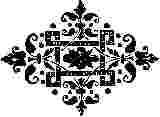
Church of Smyrna
Revelation 2:8-10
Roughly from CE 70-313.

The Seven Churches
|
The
Apostle John is the most likely angel to this period of the church.
The mantle seems to have passed from Paul to John. With Peter and Paul
both martyred and the church at Jerusalem destroyed, there must have been intense pain and
uncertainty felt in the whole Christian community. A certain restructuring of necessity
must have followed.
|

Apostle John
on Isle of Patmos |
The church at Jerusalem had been the hub of the
whole Christian world. Its fall would send shock waves to all the churches and would
also give rise for ambitious leaders to step forward into roles of leadership for which
they were ill-suited. The Lord knew this would happen.
"And unto the angel [John] of the church
in Smyrna write; These things saith the first and last, which
was dead, and is alive.
"I know thy works, and tribulation, and poverty,
(but thou art rich) and
I know the blasphemy of them which say they are Jews and are not, but are
the synagogue of Satan.
"Fear none of those things which thou shalt suffer: behold,
the devil shall cast some of you into prison, that ye may be tried; and
ye shall have tribulation for ten days: be thou faithful unto
death, and I will give thee the crown of life." Revelation 2:8-10
|
Toward the end of this period, during
the ten years of Diocletian’s closing reign from CE 303 to 313, bitter pagan
persecution occurred.
Many faithful martyrs died in this long and bitter pagan assault on
Christians.
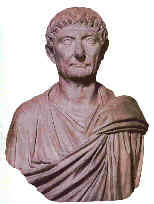
Roman Emperor Diocletian
245-313 A.D. |
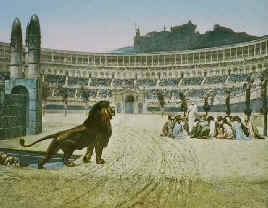
Christian Martyrs in the Coliseum
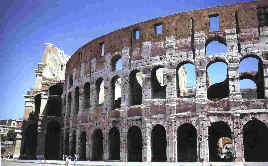
Roman Coliseum,
place of Christian persecutions. |
However, it was not the pagan persecution alone that
made life bitter. Within the church, false leaders arose grasping power and
prominence. Even the leaders of pagan Rome became enamored with them. Gibbon says
of the later days of the church at Smyrna—
"The corruption of manners and principles, so forcibly lamented by
Eusebius, may be considered as not only a consequence, but a proof of the liberty which
the Christians enjoyed and abused under the reign of Diocletian. Prosperity had relaxed
the nerves of discipline. Fraud, envy and malice prevailed in every congregation. The
proselytes aspired to the episcopal office, which every day became an object more worthy
of their ambition. The bishops, who contended with each other for ecclesiastical
pre-eminence, appeared by their conduct to claim a secular and tyrannical power in the
church...." (THE TIME IS AT HAND, p. 292. Reprinted 1983, Divine Plan, P.O. Box 144, Edison, NJ 08818). Reprinted 1983, Divine Plan, P.O. Box 144, Edison, NJ 08818).
We see the fulfillment of the words: "I
know the blasphemy of them which say they are Jews, and are not, but are the synagogue of
Satan." (Revelation 2:9) Yes, they claimed to be Jews or spiritual Israel, but
they were not. The church had become infested with men who were seeking to use
Christianity for their own purposes.
There was power and status to be found in the church, and those who had
the same ambition as Satan found opportunities to fulfill that ambition. Alas, the true
Christian found persecution from the pagan forces without and corruption eating like a
canker within.
However, the Lord observed: "I know thy works, and
tribulation, and poverty, (but thou art rich)."
(Revelation 2:9) Yes, a
faithful nucleus was "rich" in faith and in the eyes of God. To these the
encouragement is given:
|
"Fear none of those things which thou shalt suffer:
Behold, the devil shall cast some of you into prison, that ye may be
tried;
And ye shall have tribulation ten days
[years]:
Be thou faithful unto death, and I will give thee a crown of
life."
Revelation
2:10 |
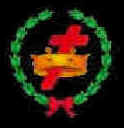
|
To the overcomers rich promises were given for which they must
wait until the "first resurrection." Those seeking personal gratification and
power often found it, but that would be their only reward. None awaited them in the
resurrection, for they were nothing more than "tares" at best and
"wolves" in the worst scenario.
Click to go to the following:
 For more information on
history of Papacy.
For more information on
history of Papacy.
Topical Studies on:
7 Churches Topical Study Home Page
Ephesus - Smyrna - Pergamos - Thyatira - Sardis - Philadelphia - Laodicea
Chapter/Verse by Verse Studies on:
7 Churches Verse by Verse Home Page
Ephesus - Smyrna - Pergamos - Thyatira - Sardis - Philadelphia - Laodicea
Topical Study Home Page - Chapter Study Home Page
- Sinaitic Manuscript - Questions - Glossary.
E-Mail
Day7000@sbcglobal.net with comments.
Copyright 2001 John Class
|